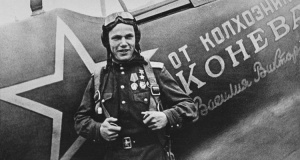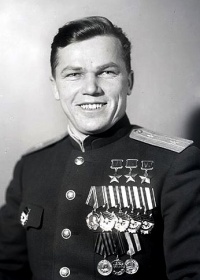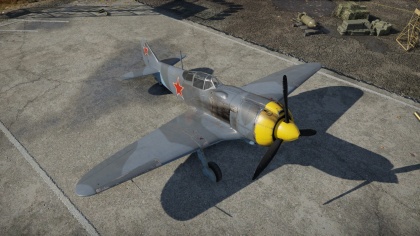La-5FN
Contents
| This page is about the Russian fighter La-5FN. For the German captured version, see La-5FN (Germany). For other uses, see La-5 (Family). |
Description
The La-5FN is a rank Russian fighter
with a battle rating of (AB), (RB), and (SB). This aircraft has been in the game since the start of the Open Beta Test prior to Update 1.27.
Being the last La-5 modification available, one can expect a similar playstyle to the previous variants, however, turn it up several notches to 11. Sporting accurate twin 20 mm cannons and amazing low altitude performance, the La-5FN is a plane with heart that can provide some blood pumping engagements.
General info
Flight Performance
Describe how the aircraft behaves in the air. Speed, manoeuvrability, acceleration and allowable loads - these are the most important characteristics of the vehicle.
| Characteristics | |||||||
|---|---|---|---|---|---|---|---|
| Stock | |||||||
| Max Speed (km/h at 6,100 m) |
Max altitude (meters) |
Turn time (seconds) |
Rate of climb (meters/second) |
Take-off run (meters) | |||
| AB | RB | AB | RB | AB | RB | ||
| 595 | 576 | 20.0 | 20.8 | 17.6 | 17.6 | 341 | |
| Upgraded | |||||||
| Max Speed (km/h at 6,100 m) |
Max altitude (meters) |
Turn time (seconds) |
Rate of climb (meters/second) |
Take-off run (meters) | |||
| AB | RB | AB | RB | AB | RB | ||
| 646 | 620 | 18.1 | 19.2 | 27.2 | 21.7 | 341 | |
Details
| Features | ||||
|---|---|---|---|---|
| Combat flaps | Take-off flaps | Landing flaps | Air brakes | Arrestor gear |
| ✓ | ✓ | ✓ | X | X |
| Limits | ||||
|---|---|---|---|---|
| Wing-break speed (km/h) |
Gear limit (km/h) |
Combat flaps (km/h) |
Max Static G | |
| + | - | |||
| 470 | ~12 | ~12 | ||
| Optimal velocities | |||
|---|---|---|---|
| Ailerons (km/h) |
Rudder (km/h) |
Elevators (km/h) |
Radiator (km/h) |
| < 380 | < 380 | < 380 | > 341 |
| Compressor (RB/SB) | ||
|---|---|---|
| Setting 1 | ||
| Optimal altitude | 100% Engine power | WEP Engine power |
| 1,550 m | 1,630 hp | 1,920 hp |
| Setting 2 | ||
| Optimal altitude | 100% Engine power | WEP Engine power |
| 4,550 m | 1,430 hp | N/A |
Survivability and armour
- 75 mm bulletproof glass in the rear windshield
- 55 mm bulletproof glass in the front windshield
- 10 mm steel plate behind the pilot seat
Armaments
Offensive armament
The La-5FN is armed with:
- 2 x 20 mm ShVAK cannons, nose-mounted (170 rpg = 340 total)
The ShVAK cannons are quite effective at this battle rating consisting of adequate damage output, a high rate of fire, and decent ammunition belts. However, they are crippled by mediocre damage per shot and by having close to the worst HEI round in the game, so one should focus on the critical components of a plane such as an engine and pilot. The cannons themselves are accurate, even in stock configuration and have the fastest rate of fire of any of its contemporaries (Hispano Mk.II's/404's, MG 151's, Ho-5's, Type 98/99's).
Suspended armament
The La-5FN can be outfitted with the following ordnance:
- Without load
- 2 x 50 kg FAB-50 bombs (100 kg total)
Usage in battles
The La-5FN is the last of the La-5 modifications available before moving on to the improved La-7 and is one of the best planes at its BR. Designed to be contemporary to the universally feared German Bf 109, it maintains excellent energy retention, adequate speed, brutal acceleration, and an amazing turn rate makes this a monster at its rank. If you made it this far in the Russian tech tree, you should understand that all but 4 Russian prop fighters are horrible above 4,000 metres, where their engines that are tuned for low-altitude will asphyxiate above that altitude, so avoid high altitude fights at all costs.
A purebred energy fighter through and through, one should employ energy fighting tactics such as stall fighting, vertical scissors and others. However, due to its fantastic turn rate, you can outturn most German, American, Italian and French fighters. Never engage in a turn fight with the British Spitfires or most Japanese fighters, as they can turn on a dime and have a relatively powerful armament.
Some enemies to be considered:
- Spitfires: The legendary British fighter is the king of low altitude fighting. It can turn on a dime, has a decent top-end speed, but has a mediocre roll rate that only gets worse at higher speeds. Avoid them at all costs unless they are unaware of your presence. In which case, dive on it and aim for the pilot and wings, as your cannons will rip through them.
- C.205 serie 3's and G.55's: These Italian menaces are heavily armed dogfighters that are effectively Bf 109's with more weapons. Their speed is almost unparalleled at this rank and excels at most fighting scenarios. If one forces a fight on you, attempt to turn fight, as when combined with combat flaps and the effective rudder, you outturn them by a decent margin.
Manual Engine Control
| MEC elements | ||||||
|---|---|---|---|---|---|---|
| Mixer | Pitch | Radiator | Supercharger | Turbocharger | ||
| Oil | Water | Type | ||||
| Not controllable | Controllable Not auto controlled |
Controllable Not auto controlled |
Controllable Not auto controlled |
Separate | Controllable 2 gears |
Not controllable |
Modules
| Tier | Flight performance | Survivability | Weaponry | |
|---|---|---|---|---|
| I | Fuselage repair | Radiator | Armored glass | DZ-40 |
| II | Compressor | Airframe | ||
| III | Wings repair | Engine | Rear armor plate | Offensive 20 mm |
| IV | Engine injection | Cover | New 20 mm cannons | |
Pros and cons
Pros:
- Excellent low altitude performance
- Fantastic energy retention
- Competitive turn rate
- Adequate speed
- Cannons are fast firing and accurate
- Leading-edge wing slats improve turn rate
- Responsive elevator authority
- Amazing acceleration turns brutal with WEP
- Sturdy for a Russian fighter
- Good armour made better with upgrades
- Can mount two underwing bombs for ground pounding
Cons:
- Asphyxiates at high altitudes
- Cannons are mediocre at best, close to the worst HEI round with a nasty habit of sparking
- Having only two cannons can is inadequate against heavier fighters and bombers
- Lower dive speed compared to contemporaries
- The bombs are only 50 kg that needs to be dropped directly on an enemy to secure a destruction
History

In early 1942, Semyon Lavochkin's LaGG-3 fighter was under threat of having its production cancelled, having proved itself to be a flawed fighter, underpowered and overweight. At the same time, Arkady Shvetsov faced a lack of demand for his M-82 radial engine, only successfully used by the Sukhoi Su-2 ground attack aircraft that was also in danger of being cancelled. The two designers met at a conference in Moscow, and Shvetsov agreed to help Lavochkin fit the M-82 engine to the LaGG-3 airframe. Mikhail Gudkov, one of the original designers of the LaGG-3, had already attempted to do the same thing, resulting in the Gu-82 fighter. However, he had delayed too long in getting the fighter into production, and by April 1942, Aleksander Yakovlev had succeeded in getting production of the LaGG-3 cancelled in favour of his Yak-7 fighter, effectively monopolising Soviet fighter production.
Lavochkin's OKB was, in the meantime, transfer to the backwaters of Tbilisi, Georgia and he and his team had to work almost illegally and in harsh conditions to modify the LaGG-3 for the M-82 engine. The radial engine was physically wider than the LaGG-3 fuselage cross-section, requiring skirting to attach the larger engine and to the fuselage, and the M-82 also had no space for an engine-mounted cannon, unlike the Klimov M-105. Thus, the updated armament changed to two 20 mm ShVAK cannon mounted on top of the engine. The new LaGG-3 M-82 (also known as the Samolyot 37 (Aircraft 37) or the Type 37) was completed in February 1942 and underwent test flights, with promising results despite problems with engine cooling. Its performance was better than any Soviet fighter then in service. Other issues revealed in testing consisted of excessive control forces, oil leaks, and excessive weight, but these could not overshadow the LaGG-3 M-82's excellent performance, and its full-scale development began as the LaG-5. The first fully operational LaG-5s was delivered on 20 June 1942.
Series LaG-5s suffered from poor quality, which reduced performance considerably. As was revealed in the test flights, pilots found it to be a more difficult aircraft to fly than the Yak-1 or LaGG-3, but the radial engine enhanced protection during head-on attacks. Redesignated La-5 in September 1942, the new fighter faced its first important test during the battle of Stalingrad. It proved not to be enough to equal the Bf 109 F-4 and G-2 models but was considered capable of further improvement. Continuous improvements to the La-5 would eventually lead to the La-5F, La-5FN, and finally the La-7, among some of the most excellent Soviet fighters of the Great Patriotic War.
In-game description
"The Lavochkin La-5 was a single-engine monoplane fighter, a single-seater with an enclosed cockpit, wooden frame and a canvas skin. FN in the designation stands for Boosted, Fuel Injection. The new variant entered production and began to reach front-line units in March 1943. The La-5FN, rather than being a successor to the earlier La-5F, was produced concurrently. Its ASh-82FN engine could reach 1,850 HP and remain at takeoff power settings for up to 10 minutes.
In April 1943 a serial La-5FN was flight tested in mock combat against a captured Bf-109G-2. The Soviet aircraft proved superior at low and medium altitudes, the most common on the Eastern Front. The La-5FN was superior both in top speed as well as maneuvering in the vertical. An analysis of these engagements led to significant changes in Soviet tactics. The La-5FN's armament was identical to that of the La-5 and consisted of twin 20mm ShVAK cannon with 200 rounds per gun. The guns were pneumatically or mechanically operated."
Notable pilots
-
 Soviet ace pilot Ivan Kozhedub, highest scoring Allied ace of WW II.
Soviet ace pilot Ivan Kozhedub, highest scoring Allied ace of WW II.
Media
https://live.warthunder.com/dl/qsU_hqp600HbuY0J/?s=_mq The skin used in the live action trailer "Victory is Ours!"
See also
All of the previous models in the La-5 line:
Next in the Lavochkin line:
External links
Paste links to sources and external resources, such as:
- topic on the official game forum;
- encyclopedia page on the aircraft;
- other literature.
| USSR fighters | |
|---|---|
| I-15 | I-15 WR · I-15 M-22 · I-15 M-25 · I-15bis · Krasnolutsky's I-15bis |
| I-153 M-62 · Zhukovsky's I-153-M62 · I-153P | |
| I-16 | I-16 type 5 · I-16 type 10 · I-16 type 18 · I-16 type 24 · I-16 type 27 · I-16 type 28 · I-180S |
| I-29 | I-29 |
| I-185 | I-185 (M-71) · I-185 (M-82) |
| I-225 | I-225 |
| ITP | ITP (M-1) |
| MiG-3 | MiG-3-15 · MiG-3-15 (BK) · MiG-3-34 |
| LaGG | I-301 · LaGG-3-4 · LaGG-3-8 · LaGG-3-11 · LaGG-3-23 · LaGG-3-34 · LaGG-3-35 · LaGG-3-66 |
| La | La-5 · La-5F · La-5FN · La-7 · Dolgushin's La-7 · La-7B-20 · La-9 · La-11 |
| Yak-1/7 | Yak-1 · Yak-1B · Yak-7B |
| Yak-3 | Yak-3 · Eremin's Yak-3(e) · Yak-3P · Yak-3T · Yak-3U · Yak-3 (VK-107) |
| Yak-9 | Yak-9 · Yak-9B · Golovachev's Yak-9M · Yak-9T · Yak-9K · Yak-9U · Yak-9UT · Yak-9P |
| Other countries | ▂P-40E-1 · ▂P-47D-27 · ▂Hurricane Mk IIB · ▂Fw 190 D-9 · ▂Spitfire Mk IXc |
| P-39 | ▂P-39K-1 · ▂Pokryshkin's P-39N-0 · ▂P-39Q-15 |
| P-63 | ▂P-63A-5 · ▂P-63A-10 · ▂P-63C-5 |





